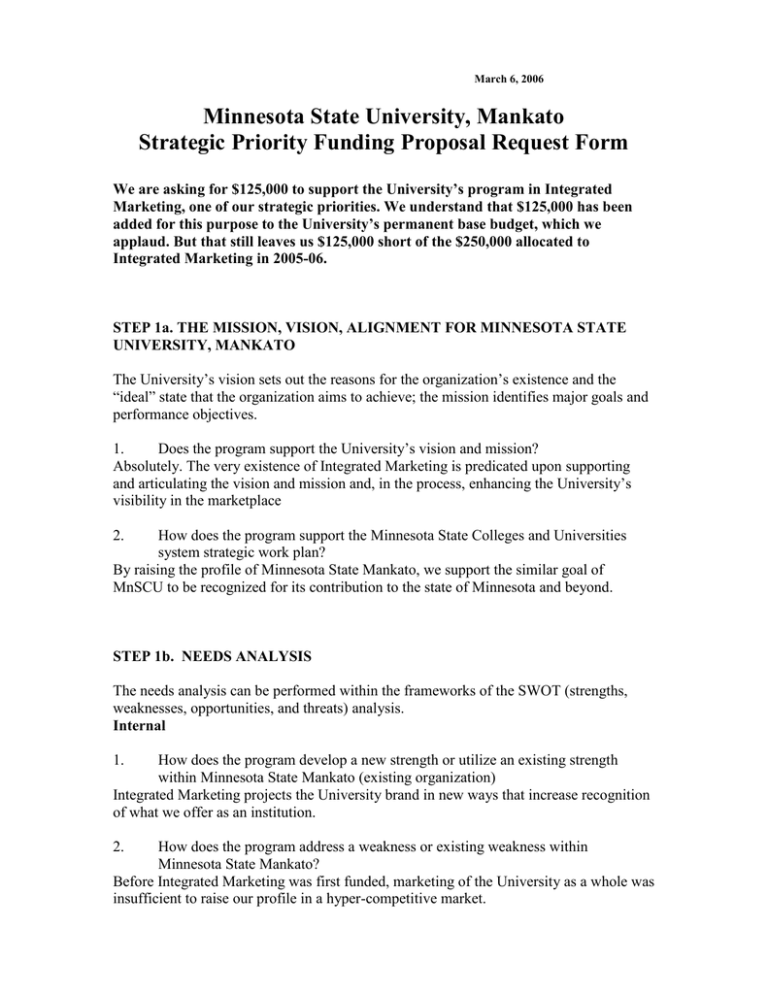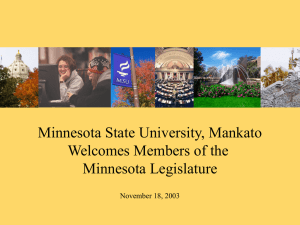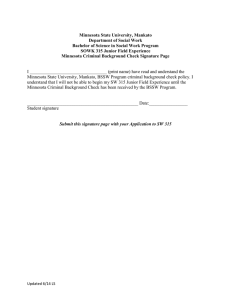Minnesota State University, Mankato Strategic Priority Funding Proposal Request Form
advertisement

March 6, 2006 Minnesota State University, Mankato Strategic Priority Funding Proposal Request Form We are asking for $125,000 to support the University’s program in Integrated Marketing, one of our strategic priorities. We understand that $125,000 has been added for this purpose to the University’s permanent base budget, which we applaud. But that still leaves us $125,000 short of the $250,000 allocated to Integrated Marketing in 2005-06. STEP 1a. THE MISSION, VISION, ALIGNMENT FOR MINNESOTA STATE UNIVERSITY, MANKATO The University’s vision sets out the reasons for the organization’s existence and the “ideal” state that the organization aims to achieve; the mission identifies major goals and performance objectives. 1. Does the program support the University’s vision and mission? Absolutely. The very existence of Integrated Marketing is predicated upon supporting and articulating the vision and mission and, in the process, enhancing the University’s visibility in the marketplace 2. How does the program support the Minnesota State Colleges and Universities system strategic work plan? By raising the profile of Minnesota State Mankato, we support the similar goal of MnSCU to be recognized for its contribution to the state of Minnesota and beyond. STEP 1b. NEEDS ANALYSIS The needs analysis can be performed within the frameworks of the SWOT (strengths, weaknesses, opportunities, and threats) analysis. Internal 1. How does the program develop a new strength or utilize an existing strength within Minnesota State Mankato (existing organization) Integrated Marketing projects the University brand in new ways that increase recognition of what we offer as an institution. 2. How does the program address a weakness or existing weakness within Minnesota State Mankato? Before Integrated Marketing was first funded, marketing of the University as a whole was insufficient to raise our profile in a hyper-competitive market. External 1. How does the program develop a new opportunity or utilize an existing opportunity within Minnesota State Mankato’s external environment? Integrated Marketing seizes opportunities to raise our profile in ways that were not possible previously, because then it was not an institutional priority and was not adequately funded. 2. How does the program address a new threat or an existing threat within Minnesota State Mankato’s external environment? Consider the following factors: demographic, technological, political, legal, social, international. The competitive threat to our University for prospective students, prospective donors and political supporters is considerable. The imminent shrinking of our prospective student pool and the recent draw-down in state financial support have sharply increased the need for competitive advantage. Integrated Marketing seeks to provide just that advantage. 3. How does this program address a market demand/need within the Minnesota State Mankato organization? Virtually all programs, both academic and nonacademic, benefit from a stronger presence in the marketplace and, conversely, are hurt by a weak, incoherent marketing program. 4. Is this program to address a legislative action? If yes, how would this program address a legislative action? STEP 2. PROGRAM JUSTIFICATION/RATIONALE Periodic evaluations of a program’s strategies, tactics and action are essential to assessing success of the strategic program planning process. 1. What are the program’s long term performance goals? To improve our University’s name recognition in the marketplace and the public perception of our quality and prestige vs. that of our competitors. 2. Who are the responsible entities for this proposed program? Jeff Iseminger, Asst VP, Integrated Marketing David Williams, VP, Advancement Integrated Marketing Team: Iseminger, Mike Cooper, Ann Rosenquist-Fee, Ted Johnson Consultants: Forte Consulting 3. What are key strategies or tactics for achieving the performance goals? By continuing to execute the new brand strategy summarized in a Communicating with Pride poster sent to all employees in February. In addition: 1. By continuing to produce and help execute marketing plans for units within the University, which now number 24. 2. By continuing to place advertising in key markets. The “media mix” used will depend on how much funding we receive beyond the base $125,000. It could include billboards, bus wraps, public television and radio underwriting, commercial television and radio ads, and targeted print ads in such demographically important media as Minnesota Monthly Magazine. 4. What are the measurable outcomes that would be used to determine if the performance goals are being achieved? A resurvey in 2007 of the random households we surveyed by phone in Mankato and the Cities in 2005. 5. How and when would the measurable outcomes be assessed? By phone survey of random households in Mankato and the Cities in 2007. 6. Identify a standard or criteria for measuring the outcomes Asking the same questions used in the 2005 phone survey to measure attitudinal shifts. 7. What are the resource needs and financial indicators (fiscal, salary, space, equipment and other non salary items)? $250,000, which is the allocation for ’05-06. It’s important to note that if we receive no additional funding beyond the currently allocated $125,000 in base budgeting, that will mean the University has slashed its investment in its Integrated Marketing priority by 50 percent. We believe that for the University to have a strong presence in the marketplace, it must sustain its funding commitment to the marketing of the University. Funding marketing in fits and starts would severely undercut the chances for the success of the program – and for the competitive success of the University. 8. What other sources of funding, self-generated income, or collaboration currently exist that are available to support this proposed program? Permanent base budget funds of $125,000. 9. What is the proposed timeline for implementation of this program? The program has already begun in ’05-06 and must continue indefinitely. Marketing is not a campaign; it’s a permanent presence in the marketplace.


